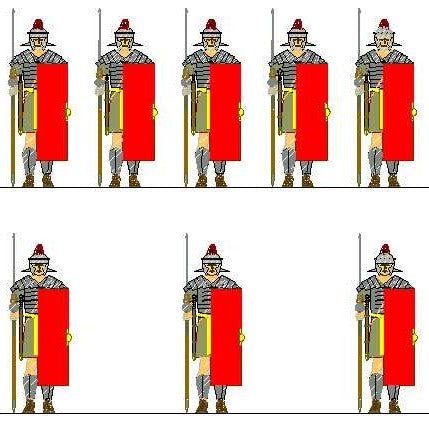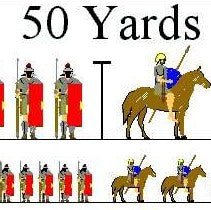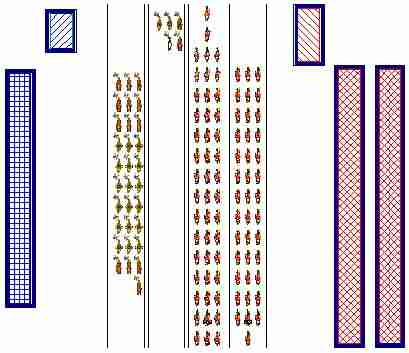A day’s march
This page is an attempt to reconstruct a 'typical' day's march for the army. Before showing the marching column there are a few basic considerations.
Distance between camps
There was surely no standard distance between camps. Estimates of the normal day's march vary but 10 miles seems to be fairly standard. That is the distance Peddie uses, for example. Ten miles is used in this model.
Time to fortify the new camp
Peddie estimates that it took three hours to complete the fortifications around the camp, Judson estimated three to four hours. I used three hours. Peddie notes that the first legionary soldiers to arrive with the vanguard do not begin fortification work but, rather, set up a protective screen to defend the site and the new arrivals. Work on fortifications didnot begin until the first of the regular legionary forces arrive.
Rate of March
This information was first presented in 'Elements of the March': "The march cadence is fairly well established. The Roman militari gradu, regular march cadence, was 100 paces per minute, the quick march cadence was 120 paces per minute. The Roman foot was (0.9708 English foot). The pace was 2.5 Roman feet, (29.124"). According to Upton, this is almost exactly the same as the US Army standard at the turn of the century; its pace was (30"), the regular march cadence was 100 paces / minute and the quick march cadence was 120 paces per minute."
At that rate the army would move 14,562 feet per hour, 2.76 miles per hour. It would take each unit a little over 3 1/2 hours to complete the ten miles between camps. Because of the length of the column, it would take a little over eight hours from the time the first units left camp until the last of the rearguard arrived at the new camp.
Peaceful and hostile marches
The Romans are said to have enforced the camp building pocedure every night, whether in peaceful or hostile environments. The main difference seems to be that the fortifications were more elaborate when there was a potential threat. Otherwise, the descritpion of the march as given here would be similar whether the army was moving through Italy on its way to the provinces or through Gaul and Spain during a campaign.
The March from Camp I to Camp II
The following illustrations show the progress of the army in 1/2 hour intervals. The outline of the old camp is shown in green on the right. The new camp is in yellow on the left. The red lines between camp indicate miles and half-mile increments. The blue lines indicate hour and half-hour time intervals. The camps and marching column are drawn to scale. The army will be seen to move across the bottom as it progresses during the nine hour march.
Start: The new camp (left) is 10 miles from the old camp (right). The lead unit, the scouts, are still in camp but are set to leave. 1/2 Hour: The scouts are about a mile and a half out, the alae of the vanguard unit are just leaving camp. The flankers are not shown in these illustrations. On each flank the two alae would leave at the same time as the scouts. At least one ala would pace the scouts about 800 yards to either side. The other ala would probably have patrolled the route to ensure that there was no infiltration once the lead ala had passed.
1/2 Hour: The scouts are about a mile and a half out, the alae of the vanguard unit are just leaving camp. The flankers are not shown in these illustrations. On each flank the two alae would leave at the same time as the scouts. At least one ala would pace the scouts about 800 yards to either side. The other ala would probably have patrolled the route to ensure that there was no infiltration once the lead ala had passed. 1 Hour: The survey and pioneer units leave camp, the general staff and officers prepare to leave.
1 Hour: The survey and pioneer units leave camp, the general staff and officers prepare to leave. 1 1/2 Hours: The first of the main body of legionaries leaves camp.
1 1/2 Hours: The first of the main body of legionaries leaves camp.
2 Hours: During this half hour the last of the legionaries leave camp. The head of the column is half way to the new camp site. The first units of the baggge train must be ready to leave the camp by this time.
2 1/2 Hours: The baggage train has just begun to leave the old camp. The head of the column is about an hour from the new campsite. By this time advance riders would have been dispatched forward to identify a suitable campsite and begin checking out the area.
3 Hours: The scouts are within a few miles of the new camp site. The advance riders would have selected the new camp site by this time, some returning to the column with the information, others staying to watch the site and scout for potential dangers. The legions are not yet at the half-way point and much of the baggage train is still inside the old camp.
3 1/2 Hours: The army would be at its most vulnerable point now. The legionaries are half way to the new camp but the lead units have not yet reached the site to begin its preparation. The army has no quick access to a safe haven. And the lengthy baggage train is almost fully exposed to attack along a 5 mile extent.
4 Hours: The scouts arrive at the new camp site and begin to secure the area. The vanguard begins to arrive at the new site.
4 1/2 Hours: The vanguard throws up a protective screen around the new camp site. The survey unit arrives and begins to lay out the walls and streets.
5 Hours: The general, officers and the first of the legions arrive. The survey unit completes camp layout.
5 1/2 Hours: With the arrival of the legions, camp fortification begins.
6 Hours: Camp fortifications progress. The dark line at the top of the camp indicates progress toward the completion of the fortifications, 1/6 of the fortifications are complete. However, the line is only symbolic of the percent completed. Work would have taken place all along the line of the walls, not just in one place. During this time period the first elements of the baggage train begin to arrive at the camp site. Servants would begin to set up tents within the camp.
6 1/2 Hours: Fortifications are 1/3 completed.
7 Hours: Fortifications are half completed. Most of the tents would be in the camp by this time, many of them set up already. The heavy baggage of the army would just be arriving and would be directed to the center of the camp.
7 1/2 Hours: By this time much of the baggage train would be unloaded and the pack mules put out to graze.
8 Hours: Fortifications are nearly completed, most of the baggage train is within the camp, nearly all of the tents have been put up.
8 1/2 Hours: The camp fortifications are completed just as the end of the baggage train arrives in camp. The rearguard approaches.
9 Hours: The rearguard is safely inside the camp walls. The vanguard legion which has been deployed in a defensive position around the camp is called inside the walls. The army is secure.
During the summer campaign months when days are long the army could be on the move for about twelve hours per day. In other seasons it would be much more difficult to maintain a ten-mile average. The day's march illustrated above is for an army fifteen miles long and takes about nine hours. A 22-mile long army would take nearly twelve hours to complete its march. Any larger army would have to shorten the distance between camps to complete the journey in a twelve hour period.
All ancient people rose early. In summer months the army would be up and moving by six. This would allow them to complete the day's march at about three in the afternoon, leaving a good portion of the day for the other tasks that would still need to be done -- caring for the pack animals, repairing equipment, cooking meals, scouting the area, foraging for food, firewood, restocking water supplies, drill and relaxation.
Conclusion
This attempt to create a detailed description of the army on the march generates a number of questions concerning the numbers of men in and associated with the army, the arrangements for the transport of their baggage and the types and quantities of supplies the army would have needed. It also makes one aware of the careful organisation that was required to sustain an army of even 4 legions in the field, especially in hostile environments. Peddie discusses the elaborate support and supply structure the army would have required. There was an almost constant flow of supplies from rear areas to the army. Caesar, for example, demanded extensive supply support from the friendly or conquered gallic tribes. None of this has been represented in the description above. Nor has the presence of the camp followers been acknowledged. Except when in hostile territory, most of the armies would have had an accompanyment of merchants, traders and women tagging along at the tail end of the column and camping just outside the walls of the camp.




